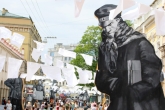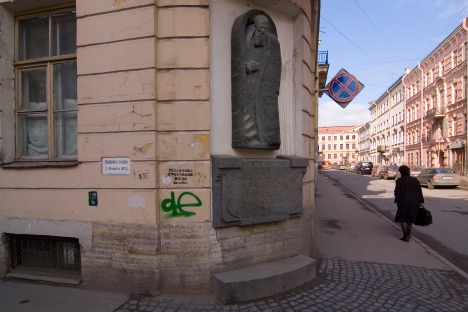
The Dostoevsky Day took place on July 6 in St. Petersburg. Source: Natalia Pietra/RG
"In the beginning of July, when it was extremely hot, near evening, a young man left his small room [ ... ] on S-y alley, went down the street and slowly, as if undecided, headed for K- Bridge ... ."
It would be difficult to walk in the footsteps of Raskolnikov—the main character of the novel—if Dostoyevsky's wife, Anna Grigorievna, had not filled in the missing letters of the street names after her husband's death. So, "S-y" Alley became Stolyarny, "K-n" Bridge became Kokushkin, and Dostoyevsky fans received a starting point for their walks.
Dostoevsky rented apartments in 20 different buildings in St. Petersburg. The reason he moved so many times was financial: The writer had constant problems with money.
Fyodor Dostoevsky always tried to choose corner apartments with a balcony and a view of a church. The building at 5/2 Kuznechny Alley later became the museum of the writer. The window of that building overlooks Vladimirsky Cathedral, and one of the walls of the building is on the street named in honor of the writer. Not far away is the Dostoevsky metro station, in which a monument stands to the writer.
The writer himself lived at the corner of Stolyarny Alley and Kaznacheisky Street when he wrote the novel. Today, a memorial plaque to him hangs on the house at 7 Kaznacheisky Street.
Dostoevsky's characters lived not far from him; however, he did not specify exact addresses. Researchers believe that this was noaccident:
"He masks them very transparently. In so doing, we should understand that we are reading literature. The real Petersburg with fictional events: Everything is connected, is transformed, and a great novel is the result," says Marina Uvarova, a researcher at the Dostoevsky Literary and Memorial Museum.
The author settled Raskolnikov at the corner of Stolyarny and Grazhdansky streets, which, in the 19th century, was called Srednaya Meshchanskaya.
The words "Home of Raskolnikov" were carved in high relief on the house at 19 Grazhdansky Street in 1999. Also found here are a sculpture of the writer and steps, which remind us that the small room of Rodion Romanovich was located right under the roof and accessible by 13 steps.

Dostoevsky settled Raskolnikov at the corner of Stolyarny and Grazhdansky streets, near the Sennoy market. Source: Lori / Legion Media
The arch leading to the courtyard, unfortunately, is closed with a gate that has a house call system, as tenants were constantly pestered by tourists and the curious.
In Dostoyevsky's time, there were as many as 22 drinking establishments on Stolyarny. It is not surprising that Raskolnikov constantly heard drunken cries from the street.
Taverns in general have an important role to play in Dostoyevsky's St. Petersburg. It is in a tavern that Raskolnikov meets Marmeladov and overhears students saying the life of the old woman is worthless.
Stolyarny Alley continues on to Kokushkin Bridge, which is a stone's throw from the key locations in the novel—the home of the old pawnbroker that Raskolnikov kills (104 Griboedov Canal), the police office (67 Griboedov Canal), Voznesensky Bridge (where drunk bureaucrat Marmeladov dies under carriage wheels), and the home of Marmeladov’s daughter Sonya, the poor girl forced into prostitution (73 Griboedov Canal Shore).
If in Dostoyevsky's time Sonya's house was "three-story, old and green," now it looks different—it was built higher and painted yellow.
Dostoevsky gives a detailed description of Sonya's room: "The wall with three windows facing the canal cut across the room sideways somehow, making one corner terribly acute, it ran in somewhere deeply so that in dim lighting it couldn't be seen very well, the other corner was too dreadfully blunt." It is the blunt corner of the house that is visible from Kokushkin Bridge.
From Raskolnikov's home to the old woman's place there are exactly 730 steps, according to the novel. A person can measure the route himself, which goes from Raskolnikov’s home, across Voznesensky Bridge, along Griboedov Canal and turns onto Srednaya Podyacheskaya Street.
In fact, no one can make it in 730 steps—it always takes more. Some researchers attribute this to the fact that Raskolnikov was tall and walking when he was very distressed; others say that the writer multiplied the number of his own steps by two.
The Griboedov Canal itself, around which the events occur, was formerly known as Yekaterinsky and called “Kanava” (“ditch”) by locals. It did not receive this scornful name for nothing: Waste was constantly dumped into it, producing an evil smell in the neighborhood.
This is the St. Petersburg that Dostoyevsky presents us with, in contrast to the prim and proper city that Pushkin once described. "Neva's majestic pulsation / The granite that her quaysides wear"—this is the grand side of the city that tourists are shown usually.
Dostoevsky Day
Every year, Dostoyevsky Day is celebrated in St. Petersburg on the first Saturday in July. It is not held in conjunction with the birth of the great Russian writer.
"Dostoyevsky was born in November, when it is cold. He died in January when, again, it is cold. The beginning of July is when the most ‘St. Petersburg’ of all his novels—‘Crime and Punishment’—begins," says the organizer of the festival, Vera Biron. Biron is the assistant director of FMD Dostoevsky Theatre.
According to her, the best actors in St. Petersburg are involved in the theatrical performances held on Dostoyevsky Day. There are many activities held in conjunction with this festival: movie showings, lectures, master classes, seminars, exhibitions and themed tours.
All rights reserved by Rossiyskaya Gazeta.
Subscribe
to our newsletter!
Get the week's best stories straight to your inbox